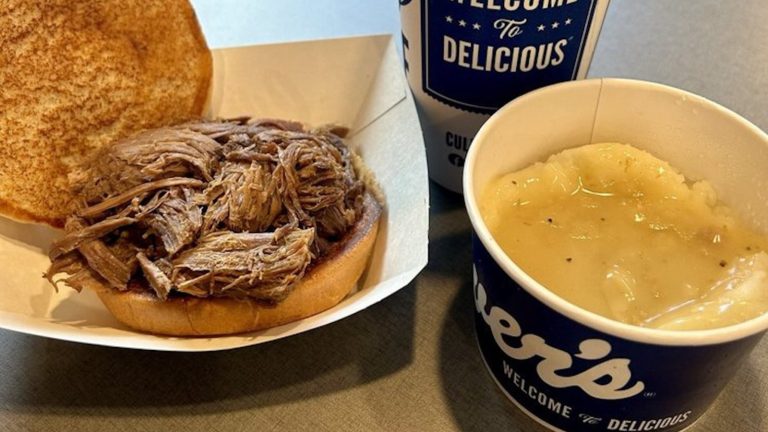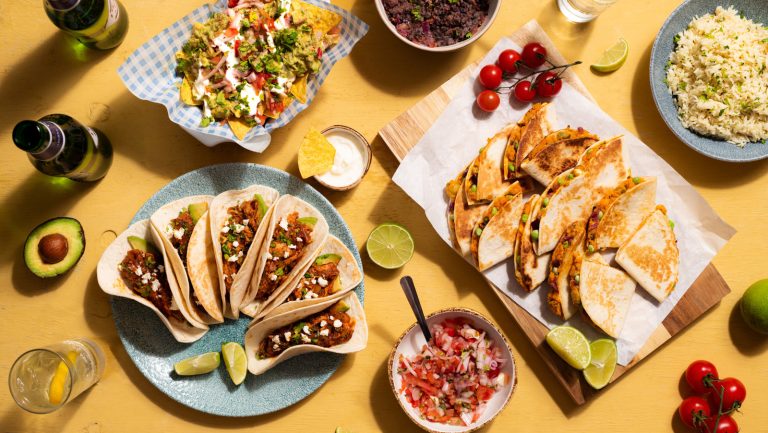We may receive a commission on purchases made from links.
Heading out to Costco isn’t like going to any other store. Sure, one of the mildly annoying things about shopping at the warehouse might be the fact that you never really know where anything is, but just think of it as going on an adventure where you’re not certain what you’re going to find. And while yes, there are a lot of phenomenal Kirkland Signature products you’re going to want to stock up on — along with those infamous bulk buys, baked goods, and packages of toilet paper so big they might not fit in your front door — there are also some things that you should skip right on past.
Canned goods might seem like a great option to stock up on at Costco, particularly because of the long shelf life associated with them. While we are fans of keeping some canned goods on hand in case of an emergency, they’re not all created equal. With that in mind, let’s take a stroll down those shelves.
What we found might surprise you, and yes, there’s a few of Costco’s beloved Kirkland Signature products on here that we just can’t recommend. Some of the problems we found with a handful of Costco’s canned goods start with sodium content, but there’s other things to consider, too. We found questionable sourcing practices, consistently poor reviews from customers, and ongoing lawsuits, which might be something you’d like to keep in mind for the next time you head to Costco.
Kirkland Signature albacore solid white tuna
There are a lot of easy and delicious canned tuna recipes, and picking up a package of Kirkland Signature’s albacore solid white tuna might seem like a great buy and the perfect thing to keep in the pantry. There are a number of problems here, though, and it starts with mercury. Testing conducted by Consumer Reports in 2023 found that albacore had the highest mercury content across multiple brands. Some samples of albacore had three times the mercury as other types of tuna, and if a simple tuna fish sandwich is your go-to multiple times a week, you should know that experts recommend limiting your albacore intake to a single can per week.
Here’s some more food for thought: Albacore tuna are not only predators that play a key role in the ecosystem of the world’s oceans, but because they’re in such high demand as a food source, wild stocks are considered overfished. Organizations like the World Wildlife Fund are still working on putting guidelines for sustainable fishing in place, and that brings us to our next problem.
In 2023, a California judge gave the go-ahead on a class action lawsuit against Costco. The lawsuit claimed the dolphin-safe label on the chain’s tuna — along with statements that Costco had made about sourcing practices — were false and consumers were being misled about things like environmental impact and fishing practices. At the time of this writing, the lawsuit has not been resolved.
Del Monte peaches
Let’s take a look at those giant cans of Del Monte peaches. Costco offers several different types — including sliced and diced peaches — in 106-ounce cans. That might be difficult to picture, but that’s more than six pounds of peaches. We’re not denying there are great ways to use canned peaches, but committing to more than six pounds of fruit feels like committing to babysitting the neighbor’s puppy for a weekend. Great … in theory. And yes, you can freeze canned peaches. However, what’s going to come out of the freezer isn’t going to have the kind of texture you’re going to want for many desserts, and there are plenty of reviews that claim Del Monte’s peaches don’t have the best texture to begin with.
We found several customers who complained of tasteless peaches, some still had pieces of the pits attached, and some noted that the cans were overly full of the syrup — to the point where they felt shorted on actual peaches. Still others reported opening the can to a funky, metallic smell and being unwilling to give them a try.
Kirkland Signature ground coffees
Costco’s Kirkland Signature range is generally a hit with customers, but there are some exceptions. When we here at Tasting Table sampled several Kirkland Signature’s whole-bean coffees, they weren’t all a complete win. And that brings us to the chain’s three-pound cans of coffee, including the 100% Colombian Supremo Bean and the Decaffeinated Dark Roast. Although they are generally well-reviewed — with some complaints about the grind being so fine that it tends to end up in the cup — it’s the size of this can that might have you rethinking things.
Unless you drink a ton of coffee, there’s a good chance that these giant cans will end up being not-so-fresh by the time you get to the end. Once you open that can, it’s only at peak freshness for up to two weeks, and possibly as little as a week.
And that’s even if it’s stored properly. The flavor loss in ground coffee happens so quickly that if you were to taste cups of coffee made from freshly ground coffee as opposed to coffee that was ground weeks ago, there’s going to be a difference. This is one thing you don’t want to buy in massive containers.
Spam
Spam is a convenient thing to keep on hand for adding some protein to meals, so Costco’s 8-count packages of this tinned meat might seem like a go-to buy. However, let’s talk numbers. Each 12-ounce can has six servings of Spam, and each serving has 770 milligrams of sodium. To put that into context, the American Heart Association (AHA) says that most Americans consume much more sodium than the 1,500 milligram ideal limit, or the 2,300 milligram recommended limit. Have two servings of Spam, and you’re already at your daily limit.
Processed foods — like Spam — are a huge source of sodium, and the AHA also warns that consistently consuming too much can lead to things like heart failure, stroke, certain types of cancer, and kidney disease. The processing that Spam goes through adds more than ordinary sodium, as sodium nitrite is one of the additives used to give Spam that notoriously long shelf life.
Sodium nitrite is used as a preservative, which can be converted to nitrosamine — this compound is linked to higher instances of certain types of cancers, diabetes, and brain tumors. It’s convenient for an occasional meal, but experts warn that it shouldn’t be relied on to be a regular source of protein and nutrition.
Del Monte canned whole kernel corn
Vegetables can be pretty polarizing, but even if you might not love spinach, artichokes, or sprouts, there’s a good chance that corn is a win. Nothing can compare to whole, fresh corn for grilled Mexican street corn, but canned corn can be a great option for those long months when the fresh stuff just isn’t available. Costco carries bulk packages of Del Monte’s canned whole kernel corn, and it’s generally highly reviewed. This is a case where reading labels comes in handy, though, as you’ll notice that every half-cup serving contains 320 milligrams of sodium.
That’s around a fifth of what the American Heart Association recommends limiting your entire daily intake to, and with 3 ½ servings in one of those 15 ¼-ounce containers, adding the whole can to your meal can mean you’re adding a lot more sodium than you’d expect. It’s easy to do, too: If you’re whipping up a classic succotash or serving a kale and corn salad, you could easily use the whole can.
It’s worth noting that although corn brings a lot of nutritional benefits to the table, sodium is one of the things that experts caution consumers to check for. Del Monte isn’t alone in having a canned corn that’s surprisingly high in sodium, and experts even suggest plain, sauce-free frozen corn as a better, still-affordable option.
Ox & Palm corned beef
Australia is known for its beef production, so seeing the labels on Ox & Palm Corned Beef might be enough to make you want to pick up a case. It’s made in Australia from 100% Australian beef, and while that seems like it might be a good thing, reviews for this particular product aren’t all great.
Yes, some people swear by it, but check out online reviews and you’ll find a lot of complaints about the fat content. Customers report getting cans with large chunks of fat, sinew, and some have even claimed to have gotten bone fragments, with others claiming to have found cartilage, veins, and other mystery bits. Just a few unhappy customers are to be expected, but when multiple people start saying the same thing, is it worth the risk?
Customers also complain about this brand being way too salty, and it’s no wonder. One two-ounce serving (from the 11 ½-ounce can) contains 300 milligrams of sodium. That means the whole can contains a day’s worth of sodium, which is a great example of why the American Heart Association warns that many people consume too much sodium.
Del Monte green beans
Canned green beans might seem like another great option to keep in the pantry, especially during the winter months. Costco carries Del Monte’s cut green beans, but there are a few reasons you might want to skip these. It starts with the sodium content: One half-cup contains 380 milligrams of sodium, which is a surprising amount.
There’s something else going on here, too, and it might make you skip canned green beans altogether. Generally speaking, most canned vegetables are pretty nutritious. A lot of the vitamins and nutrients — like vitamins A and C — are preserved in a relatively decent amount. However, vitamin C is lost during the canning process, and one study that looked into nutrition loss during canning found that green beans were especially vulnerable to nutrient loss.
The joint study was done by several French organizations, including Avignon Université and the INRAE, and it found that the canning process resulted in the loss of more than 80% of the vitamin C found in green beans. Other studies done on frozen green beans found a much higher nutrient retention rate, so you may want to swap those cans for freezer bags.
Rosarita organic refried beans
Costco offers a few different sizes of Rosarita’s organic refried beans, and we get it. Refried beans are delicious, and it’s totally tempting to pick up that 7-pound can. The one we’re talking about comes in 16-ounce cans, but there are a few things to consider here. That starts with the sodium, because one ½ cup serving has 550 milligrams of sodium. It’s easy to see why the American Heart Association stresses that Americans tend to consume too much.
And here’s the other thing that gives us pause about this one: Refried beans are really easy to make at home. If you have an Instant Pot, you can use dried beans without soaking them, and it actually takes less than an hour, and most of that is hands-off cooking time. Not only can you season and salt them however you like, but going this route is cheaper.
Savvy shoppers who have worked out the cost of using canned or dried beans have found that dried beans are much more cost-effective. Buy in bulk, and you’ll have the added bonus of keeping dried beans on hand, which is more handy than you might expect. There are all kinds of dishes that beans are excellent in, like soups, stews, tacos, and we can’t forget about chili! Dried beans also last a really long time — up to and perhaps beyond a year if stored properly, meaning that if you’re getting canned beans for shelf life, dried beans are a better option.
Nestle Nido toddler formula
Parents are faced with making a lot of tough choices, and what to feed babies and infants is up there as one of the most overwhelming. Costco’s Nestle Nido powdered milk might seem like a reliable option to supplement even the pickiest of toddlers.
In 2024, an investigation into Nestle products reported on findings claiming that the corporation had different formulas for different areas. Products that were sold in what were defined (via Time) as “low and middle-income nations” had high levels of sugar added, while the formula sold in other countries, particularly European countries, didn’t have as much sugar added. Nestle issued a statement saying that it complied with each country’s regulations regarding baby and toddler formula. The version sold in Costco comes from Mexico, and a look at the nutritional information shows that a serving contains 17 grams of sugar. Added sugar content is listed as zero, but when it comes to a child’s nutrition, is there such a thing as too much information?
Libby’s Vienna sausages
Libby’s Vienna sausages have a definite vibe, and it’s the stuff of cocktail parties of the 1970s. Fortunately, there are all kinds of ideas for unconventional hors d’oeuvres that’ll have dinner guests asking for the recipes, and that means there’s no reason to reach for those little cans of Libby’s Vienna sausages. That’s good news, because even though Costco offers bulk packages of relatively reasonable-sized cans, you’ll want to skip these.
We do have to give Libby’s kudos for one thing, and that’s defining a single serving as one full, 4.6-ounce can. That makes the math easy: One can has 820 milligrams of sodium, and to put that in perspective, that’s around half of what the American Heart Association says is the ideal daily limit for sodium.
If that’s not enough of a reason to leave this one on the shelves, we also have to say that there are plenty of customers who just aren’t thrilled with the product itself. Many who ordered online from Costco report getting dented, crushed, or burst cans, while other low-star reviews report odd smells, textures, and that they’re the kind of odd-tasting processed meat that’s only good in case the world ends and you get super desperate.
Campbell’s Simply chicken noodle soup
When you’re feeling under the weather, there are few things that are more comforting than a bowl of chicken noodle soup. Campbell’s is a well-known and trusted brand, and the Simply Chicken Noodle Soup offered at many places, including Costco, might seem like a great idea. There’s a drawback, though, and that starts with sodium. One serving has 680 milligrams of sodium, and that’s the equivalent of half the can. Use the whole can, and that’s over the 1,500 milligrams of sodium that the American Heart Association says you should be aiming for in a single day.
It’s not entirely surprising to learn that reviews of the soup itself are mixed, with some customers claiming it’s way, way too salty. Others add that salt is the only flavor that they can taste, with entire Reddit threads devoted to complaints and suggestions on how to make the soup palatable. That involves adding a lot of seasoning, and if you need to do that anyway, why not just make your own chicken carcass soup? Just pick up a rotisserie chicken from Costco instead of the cans, and freeze servings for later.
Reviews on the Costco website suggest another problem, and it’s one we noticed on many of the reviews of the canned goods we looked at. Countless customers who order online report getting badly damaged or crushed cans that ruined entire orders.
Chef-mate corned beef hash
One of the best things about canned foods is the convenience. Coupled with the long shelf life, it’s why many of us might choose to stock up on bulk buys at Costco, but let’s talk about the Chef-mate Corned Beef Hash. Corned beef hash is an incredibly versatile ingredient with a ton of uses, so we can see that you might be able to crack open that 6-pound can from Costco and use it in meatloaf, quiches, omelets, and casseroles before it gets boring. But reviews for this particular product are less than stellar.
Sure, some people say that it’s fine, but more call it incredibly greasy and claim to have gotten cans that have more fat than meat. It’s called unbearably greasy and equally salty — and yes, it has 1,360 milligrams of sodium per one-cup serving.
Unhappy customers say that when they cooked it according to the directions, they ended up with hash that was swimming in grease. Some claim to have gotten hard pieces in it, and plenty of other reviews call it completely lacking in flavor (other than salt). To make this palatable, customers say they needed to add seasoning, more meat, potatoes, and even vegetables, and at that point, you may as well just make your own.
Methodology
In order to compile a list of canned goods that you should skip at Costco, we started by looking at customer reviews of each product and determining which ones had consistently poor ratings. We looked at complaints regarding things like taste, texture, and the lack of ease of use. We also took into account things like sodium content, sourcing policies, and transparency in regards to nutritional information.





